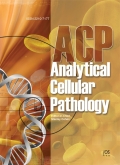Authors: de Wilde, Jillian | De-Castro Arce, Johanna | Snijders, Peter J.F. | Meijer, Chris J.L.M. | Rösl, Frank | Steenbergen, Renske D.M.
Article Type:
Research Article
Abstract:
Background: Previous studies demonstrated a functional involvement of the AP-1 transcription factor in HPV-induced cervical carcinogenesis. Here, we aimed to obtain further insight in expression alterations of AP-1 family members during HPV-mediated transformation and their relationship to potential regulatory (Notch1, Net) and target (CADM1) genes. Methods: mRNA expression levels of c-Jun, JunB, junD, c-Fos, FosB, Fra-1, Fra-2, Notch1, Net and CADM1 were determined by quantitative RT-PCR in primary keratinocytes (n=5), early (n=4) and late (n=4) passages of non-tumorigenic HPV-immortalized keratinocytes and in tumorigenic cervical cancer cell lines (n=7). In a subset of cell lines protein expression and AP-1 complex
…composition was determined. Results: Starting in immortal stages c-Fos, Fra-2 and JunB expression became up regulated towards tumorigenicity, whereas Fra-1, c-Jun, Notch1, Net and CADM1 became down regulated. The onset of deregulated expression varied amongst the AP-1 members and was not directly related to altered Notch1, Net or CADM1 expression. Nevertheless, a shift in AP-1 complex composition from Fra-1/c-Jun to c-Fos/c-Jun heterodimers was only observed in tumorigenic cells. Conclusion: HPV-mediated transformation is associated with altered AP-1, Notch1, Net and CADM1 transcription. Whereas the onset of deregulated expression of various AP-1 family members became already manifest during the immortal state, a shift in AP-1 complex composition appeared a rather late event associated with tumorigenicity.
Show more
Keywords: Cervical cancer, HPV, AP-1, Fra-1, c-Fos, Net, Notch1, CADM1
Citation: Analytical Cellular Pathology,
vol. 30, no. 1, pp. 77-87, 2008
Price: EUR 27.50





